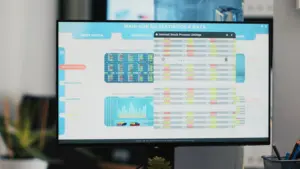The tableau consists of a workbook and sheet file structure, similar to Microsoft Excel. A workbook contains sheets, and a sheet can either be a worksheet, a dashboard, or a story.
- A worksheet comprises a single view along with shelves, cards, legends, and the Data and Analytics panes in its sidebar.
- A dashboard is a collection of the views from multiple worksheets.
- A story consists of a sequence of worksheets or dashboards, which work together to convey information.
How to create new worksheets?
There are many ways to create new sheets in a workbook, dashboard, or a story. You can also create as many sheets in a workbook as you want.
For creating a new worksheet, dashboard, or story, click on the New Worksheet, New Dashboard, or New Story button available at the bottom of the workbook.
For renaming a new worksheet, dashboard, or story, right-click (Ctrl-click on a Mac) the tab and then select the Rename command.
Another way to create new Tableau worksheets:
- Select Worksheet > New Worksheet.
- Right-click on an open tab in the workbook and select New Worksheet from the menu.
- On the toolbar, click on the drop-down arrow on the New Worksheet button and select New Worksheet.
- Press Ctrl + M on your keyboard.
How to undo, redo, or clear sheets?
Every Tableau workbook consists of a history of steps you have performed on the Tableau Worksheets dashboards, and stories in that available workbook for the current work session.
To move backward through the history, click on Undo on the toolbar or press Ctrl + s on your keyboard.
To move forward through the history, click on Redo on the toolbar or press Ctrl + Y on your keyboard.
For removing all fields, formatting, sizing, axis ranges, filters, sorts, and context filters in the sheet, click on the Clear Sheet on the toolbar.
To clear any specific aspects of the view, use the Clear Sheet drop-down menu.
How to duplicate a sheet?
Whenever you want to use an existing sheet as a jumping-off point, you can duplicate that sheet. The duplicated sheet consists of all of the same fields and settings as a starting point for new analysis.
Duplicate also creates a new version of a Tableau worksheets, dashboard, or story you can modify without affecting the original sheet.
To duplicate the active sheet, right-click on the sheet tab and select Duplicate.
How to duplicate as Crosstab?
A crosstab, also known as Pivot Table, is a table that summarizes data in rows and columns of text. It is an easy way to display the numbers associated with the data view.
Create a new crosstab sheet based on the current sheet’s data, right-click the sheet tab, and select Duplicate as Crosstab. Alternatively, select Worksheet > Duplicate as Crosstab.
This command will insert a new worksheet into your workbook and populates the sheet with a crosstab view of the original worksheet’s data. Tableau Dashboards and stories cannot be duplicated to crosstabs.
How to rename sheets?
To rename the active sheet, right-click the sheet in the sheet tab along the bottom of the workbook, and then click Rename Sheet.
Alternatively, double-click the sheet’s name in a sheet tab, type a new name, and then click Enter.
How to see the underlying data in a sheet?
To see the numbers available behind the marks in your view, hover over or click on a mark for displaying the associated data in a tooltip. When the tooltip opens, click the View Data command at the tooltip’s top to view underlying data.
Right-click the view (without selecting marks), and then click View Data.
You can also copy and paste that data into Excel or another application. For exporting the underlying data, click Export All.
How to delete sheets?
Deleting a sheet will remove it from the workbook, and there must always be at least one worksheet in a workbook.
Deleting the active sheet, right-click the sheet in the sheet tab along the bottom of the workbook, and then click Delete.
Worksheets used in a dashboard or story cannot be deleted, but they can be hidden.
A worksheet used as Vis in Tooltip can be hidden or deleted.
How to create a paged workbook?
A paged workbook helps to save the data’s view in different pages for different values of the dimension or measure. A basic example is to see how each type of product has performed against each other in a specific sales region. As each value of product type is stored as a separate page, we can view it one at a time or can see it as a range of values.
The paged workbook contains worksheets that have fields put in the page shelf. Take the example of studying the profit of various sub-categories of products in different regions. The following are the steps.
Step 1: Create a bar chart with the help of two dimensions and one measure. Here, drag the Measure Profit to the columns shelf and the dimensions sub-category and Region to the rows shelf, as given in the below screenshot.
Step 2: Drag the field Sub-Category again to the page shelf. You will see that a page control will be automatically added, just below the Pages shelf. This page control will provide the following features to navigate through the pages in a view:
- Jump to a specific page.
- Manually advance through the pages.
- Automatically advance through pages.
Here, we will see how to jump to a specific page and get the automatic display of pages. To go to a particular page, click on the drop-down on the page control and select Accessories. The chart seen in the below screenshot appears.
Step 3: For automatic display of pages, keep the checkbox show history as ticked and click the play button. You will then see an automatic play of different pages of sub-categories. While the value of the current Sub-Category is shown with a dark color, the previous values are shaded with light color. The below screenshot illustrates this.
How to reorder worksheets?
Sometimes you will need to change the position of the existing worksheet to study them in a better way. It can be done by dragging the sheet name from its current position to the new position.
For reordering a worksheet, click and hold the worksheet name and move it to the required position. Consider the Tableau Worksheets, as shown in the below screenshot.
The below screenshot shows that a vertical dark line appears in the new position after dragging the third worksheet from the left to the new position.



























2 Responses